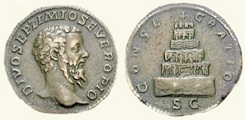Accounts of the Death
According to Cassius Dio:
-
“While [Septimius Severus] was .. engaged [in preparing to attack the Caledonians during his f British campaign], his sickness carried him off on the 4th of February [at Eboracum, modern York] ... [B]efore Severus died, he is reported to have spoken thus to his sons [Caracalla and Geta] ...:
-
‘Be harmonious, enrich the soldiers, and scorn all other men’.
-
After this his body was arrayed in military garb and placed upon a pyre and, as a mark of honour, the soldiers and his sons ran about it; and as for the soldiers' gifts, those who had things at hand to offer as gifts threw them upon it, and his sons applied the fire. Afterwards his bones were put in an urn of purple stone, carried to Rome, and deposited in the tomb of the Antonines [i.e. the mausoleum of Hadrian, now the Castel Sant' Angelo]” (‘Roman History’, Epitome of Book 77: 15: 2-4).
Herodian provided a similar description of these events:
-
“Thus Severus died after ruling for 18 years, and was succeeded by his young sons [Caracalla and Geta], to whom he left an invincible army and more money than any Emperor had ever left to his successors. ... Thus, with both of them managing imperial affairs with equal authority, the two youths prepared to sail from Britain and take their father's remains to Rome. After burning his body and putting the ashes, together with perfumes, into an alabaster urn, they accompanied this urn to Rome and placed it in the [mausoleum of Hadrian]” (‘History of the Roman Empire’, III:15)”.
He continued the account in Book IV:
-
“When they arrived in Rome, the people welcomed them with laurel branches and the Senate, too, came out to greet them. [Caracalla and Geta] headed the procession, wearing the imperial purple; the Consuls for that year followed, carrying the urn which held the ashes of Severus. Then those who had come out to greet the young Emperors passed by the urn and paid their respects to the [deceased] Emperor. The procession escorted the urn to the [mausoleum of Hadrian]. After performing the rites prescribed for new Emperors, the youths entered the imperial palace. .... But before doing anything else, the emperors performed the funeral rites for their father” (‘History of the Roman Empire’, IV:1: 3-4).
Herodian then described these rites, which he probably witnessed:
-
“It is the Roman custom to elevate to divine status those Emperors who, at their death, leave sons or designated successors; they call this honour deification. To begin with, public mourning ... is observed throughout the entire city [of Rome]. After a costly funeral, the body of the Emperor is interred in the customary fashion. But then a wax image is fashioned in the exact likeness of the corpse and placed ... on the couch like a sick man ... The couch is then carried out of the city to the Campus Martius, where ... a square building has been constructed entirely of huge wooden beams in the shape of a house. The whole interior of this building is filled with firewood ... Upon this structure rests a smaller second storey, similar in shape and ...[above it] there is a third and a fourth storey, each smaller than the one beneath it; finally, the smallest storey of all tops this structure. They bring the couch to this structure and carry it up to the second storey; ... When [the appropriate] rites have been completed, the Emperor's successor puts a torch to the structure, after which the people set it on fire on all sides. ... From the topmost and smallest storey,... an eagle flies forth...: the Romans believe that this eagle carries the soul of the Emperor from the earth up to Heaven. Thereafter the Emperor is worshiped with the rest of the gods” (‘History of the Roman Empire’, IV: 2.
Consecration Coins

DIVO SEPTIMIO SEVERO PIO/ CONSECRATIO S-C
RIC IV: p 292 490B (Rome)
Caracalla minted a number of coins for his deified father at Rome, catalogued in RIC IV: at pp 239, 191 A-F; and at p 292, 490 A-B. The reverse designs depicted:
-
✴a standing eagle on:
-
•a thunderbolt (191 A and B; and 490 A);
-
•a globe (191 C); or
-
•an altar (191 D);
-
✴a wreathed empty throne (191 E); or
-
✴ funerary pyre surmounted by a quadriga (191F, illustrated by the British Museum; and 490B, illustrated above).
All of these coins has the reverse legend CONSECRATIO, and 490 A-B also have the initials ‘S-C’ (senatus consultum) on the lower part of the reverse, which implies that the Senate had ratified this consecration.
Read more:
‘RIC’ - see Mattingly and Sydenham (1936) below
H. Mattingly and E. Sydenham, “Roman Imperial Coinage, Vol. IV, Part I: Pertinax to Geta”, (1936) London
Severan Dynasty (193 - 235 AD): Main Page
Death of Septimius Severus (211 AD) Elagabalium/ Temple of Jupiter Ultor
Return to the History Index



